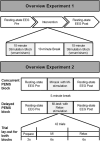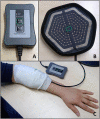Peripheral Electrical Stimulation Modulates Cortical Beta-Band Activity
- PMID: 33867919
- PMCID: PMC8044771
- DOI: 10.3389/fnins.2021.632234
Peripheral Electrical Stimulation Modulates Cortical Beta-Band Activity
Abstract
Low-frequency peripheral electrical stimulation using a matrix electrode (PEMS) modulates spinal nociceptive pathways. However, the effects of this intervention on cortical oscillatory activity have not been assessed yet. The aim of this study was to investigate the effects of low-frequency PEMS (4 Hz) on cortical oscillatory activity in different brain states in healthy pain-free participants. In experiment 1, PEMS was compared to sham stimulation. In experiment 2, motor imagery (MI) was used to modulate the sensorimotor brain state. PEMS was applied either during MI-induced oscillatory desynchronization (concurrent PEMS) or after MI (delayed PEMS) in a cross-over design. For both experiments, PEMS was applied on the left forearm and resting-state electroencephalography (EEG) was recording before and after each stimulation condition. Experiment 1 showed a significant decrease of global resting-state beta power after PEMS compared to sham (p = 0.016), with a median change from baseline of -16% for PEMS and -0.54% for sham. A cluster-based permutation test showed a significant difference in resting-state beta power comparing pre- and post-PEMS (p = 0.018) that was most pronounced over bilateral central and left frontal sensors. Experiment 2 did not identify a significant difference in the change from baseline of global EEG power for concurrent PEMS compared to delayed PEMS. Two cluster-based permutation tests suggested that frontal beta power may be increased following both concurrent and delayed PEMS. This study provides novel evidence for supraspinal effects of low-frequency PEMS and an initial indication that the presence of a cognitive task such as MI may influence the effects of PEMS on beta activity. Chronic pain has been associated with changes in beta activity, in particular an increase of beta power in frontal regions. Thus, brain state-dependent PEMS may offer a novel approach to the treatment of chronic pain. However, further studies are warranted to investigate optimal stimulation conditions to achieve a reduction of pain.
Keywords: electroencephalography; nociception; peripheral electrical stimulation; sensorimotor rhythm; state-dependent stimulation.
Copyright © 2021 Arendsen, Guggenberger, Zimmer, Weigl and Gharabaghi.
Conflict of interest statement
TW is the founder and CEO of Bomedus GmbH, the company that developed the stimulation device used in this study. The remaining authors declare that the research was conducted in the absence of any commercial or financial relationships that could be construed as a potential conflict of interest. The reviewer EL-L declared a past co-authorship with one of the authors AG to the handling editor.
Figures





References
-
- Arendsen L. J., Hugh-Jones S., Lloyd D. M. (2018). Transcranial alternating current stimulation at alpha frequency reduces pain when the intensity of pain is uncertain. J. Pain 19 807–818. - PubMed
LinkOut - more resources
Full Text Sources
Other Literature Sources

